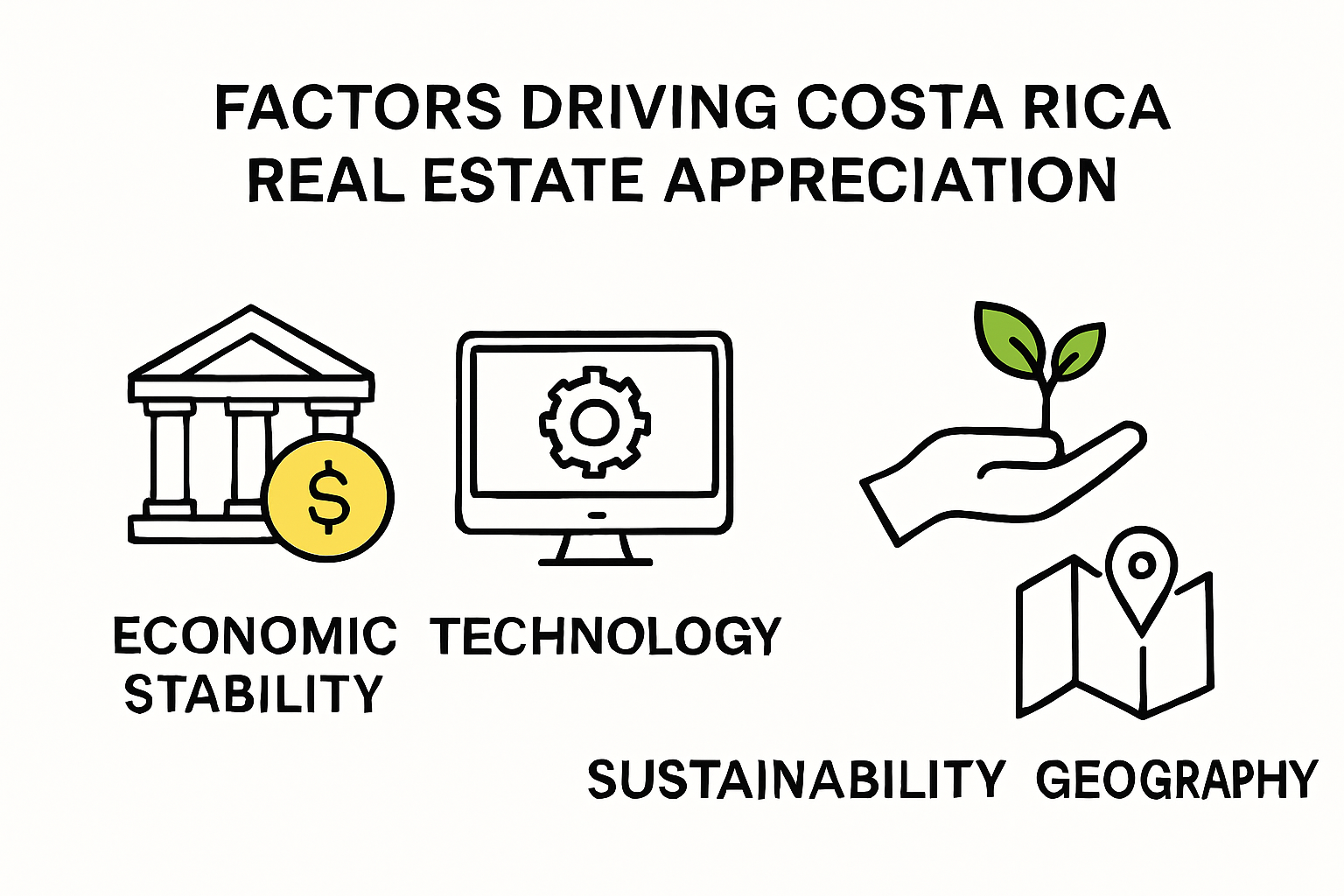Costa Rica’s real estate scene is catching global attention, and it is not just because of the endless beaches or tropical climate. Some coastal regions like Tamarindo and Nosara have seen property prices drop by as much as 30 percent, opening doors for new investors. Most people assume the market’s hottest feature is its affordability or postcard views. In reality, it is the tech-ready infrastructure and sky-high demand for sustainable, green-certified properties that are driving values in ways you might not expect.
Table of Contents
- Costa Rica Real Estate Appreciation Factors
- 2025 Market Trends And Investment Hotspots
- Maximizing Returns For Investors And Expats
- Risks, Challenges, And Long-Term Outlook
Quick Summary
| Takeaway | Explanation |
|---|---|
| Investment in sustainable properties is crucial. | Properties with green certifications are valued higher in Costa Rica’s real estate landscape. |
| Leverage mixed-use developments for income. | Properties combining residential and commercial uses can optimize revenue streams and appeal to diverse buyer segments. |
| Focus on emerging hot spots like Guanacaste. | Regions like Tamarindo and Nosara are rising in popularity, driven by tourism and infrastructure gains. |
| Understand local regulations thoroughly. | Familiarity with Costa Rica’s property ownership laws is vital to avoid delays and make informed investments. |
| Adaptability to market changes is key. | Investors should develop flexible strategies to align with evolving economic conditions and buyer preferences. |
Costa Rica Real Estate Appreciation Factors
Costa Rica’s real estate market continues to demonstrate remarkable resilience and sustained growth, driven by a complex interplay of economic, demographic, and lifestyle factors. Understanding these appreciation drivers provides critical insights for investors seeking strategic opportunities in this dynamic market.

Economic Fundamentals Driving Property Values
The country’s economic stability serves as a primary catalyst for real estate appreciation. Costa Rica has consistently maintained a stable macroeconomic environment, attracting both domestic and international investors. The government’s commitment to economic diversification has created multiple revenue streams beyond traditional agricultural exports, including robust tourism, technology services, and foreign direct investment.
Digital transformation and remote work trends have significantly accelerated property value growth. The nation’s strategic digital nomad visa program has positioned Costa Rica as a premier destination for location-independent professionals. Tech workers and entrepreneurs are increasingly viewing the country not just as a temporary retreat but as a long-term residential option, driving demand in urban centers and coastal regions alike.
Geographic and Lifestyle Appreciation Factors
Unique geographical attributes contribute substantially to real estate appreciation. Costa Rica’s diverse landscapes ranging from pristine beaches to verdant mountain regions create multiple micromarkets with distinct investment potential. Coastal areas like Tamarindo, Nosara, and Santa Teresa have witnessed exponential growth due to their combination of natural beauty, developed infrastructure, and international accessibility.
Lifestyle appeal plays a crucial role in sustained property value increases. The country’s reputation for environmental sustainability, high quality of life, and political stability attracts affluent investors seeking both personal residence and investment opportunities. The concept of “pura vida” extends beyond a cultural motto to become a tangible real estate value proposition, drawing high-net-worth individuals looking for meaningful lifestyle investments.
Additionally, foreign investment regulations that welcome international buyers without significant restrictions have created a transparent and accessible real estate market. Investors can own property with the same rights as local citizens, which reduces barriers and increases market confidence.
Economic projections suggest continued appreciation potential. With forecasted GDP growth hovering around 4% and sustained foreign direct investment, real estate in Costa Rica represents a compelling investment landscape. The combination of economic stability, lifestyle advantages, and strategic geographic positioning makes the market particularly attractive for long-term wealth generation.
For investors seeking deeper insights into navigating this dynamic market, explore our comprehensive guide on private lending strategies that can help maximize real estate investment potential in Costa Rica.
Below is a table summarizing the primary factors driving real estate appreciation in Costa Rica to help readers quickly compare and understand their relative impacts.
| Appreciation Factor | Description | Impact on Property Value |
|---|---|---|
| Economic Stability | Consistently stable macroeconomic environment, diversified economy | High |
| Technology & Digital Nomads | Digital transformation and visa program attracting remote professionals | High |
| Geographic Diversity | Varied landscapes create distinct micromarkets with unique potential | Moderate to High |
| Lifestyle Appeal | Environmental sustainability, high quality of life, political stability | High |
| Investment Regulations | Transparent process with rights for international buyers | Moderate |
| Infrastructure Development | Improved roads, tech, and amenities in key regions | Moderate to High |
| Foreign Direct Investment | Ongoing investment from abroad boosting market confidence | Moderate |
2025 Market Trends and Investment Hotspots
The Costa Rican real estate market in 2025 presents a nuanced landscape of opportunities and strategic investment potential. Emerging trends reveal a dynamic market characterized by shifting price points, evolving buyer demographics, and regional variations that demand sophisticated investment approaches.
Regional Market Dynamics
Several key regions stand out as prime investment destinations in 2025. The coastal areas of Guanacaste continue to attract significant attention, with Tamarindo and Nosara emerging as particularly attractive markets. These locations benefit from a perfect blend of natural beauty, developed infrastructure, and robust tourism potential. The digital nomad ecosystem has transformed these regions into global hotspots, driving property values and rental demand.
Urban centers like San Jose and surrounding metropolitan areas are experiencing a renaissance of their own. Technology corridors and emerging business districts are creating new investment opportunities. Properties near technology parks and innovation centers are seeing accelerated appreciation, reflecting the country’s growing reputation as a technology and service hub.
The following table compares notable regional hotspots and key features that make them attractive to investors in 2025.
| Region | Key Features | 2025 Market Trend |
|---|---|---|
| Tamarindo | Strong tourism, price drops (up to 30%), infrastructure | Rising interest, accessible entry point |
| Nosara | International appeal, digital nomad demand | High rental demand, growing market |
| Santa Teresa | Natural beauty, developed community | High appreciation, niche market |
| San Jose | Tech/business hubs, urban amenities | Urban revitalization, steady growth |
| Greater Guanacaste | Coastal proximity, infrastructure investment | Emerging hotspot, infrastructure gains |
Emerging Investment Strategies

Investors in 2025 are adopting more sophisticated approaches to Costa Rican real estate. The market has witnessed a significant shift towards properties that offer multiple revenue streams. Mixed-use developments that combine residential, commercial, and short-term rental potential are gaining substantial traction. Investors are increasingly looking for properties that can generate income through various channels, from long-term rentals to tourism-focused short-term accommodations.
The price landscape has become more nuanced. While some regions have experienced modest price corrections, others continue to show strong appreciation potential. The median property prices have become more accessible, with a notable 30% decrease in some markets, creating attractive entry points for both domestic and international investors. This price adjustment, coupled with strong demand from remote workers and digital nomads, has created a unique investment environment.
Technology and Sustainability Driving Value
Sustainability has transformed from a niche consideration to a primary driver of real estate value in Costa Rica. Properties with green certifications, energy-efficient designs, and minimal environmental impact are commanding premium valuations. The market increasingly rewards developments that demonstrate a commitment to ecological preservation and sustainable living.
Technology infrastructure has become a critical factor in property valuation. Areas with robust digital connectivity, high-speed internet, and smart home capabilities are seeing accelerated appreciation. The digital nomad visa program continues to drive demand for properties that cater to location-independent professionals, creating a new segment of real estate investment.
For investors seeking a comprehensive understanding of navigating these complex market dynamics, explore our in-depth private lending strategies that can help maximize investment potential in this evolving real estate landscape.
The 2025 Costa Rican real estate market represents a sophisticated ecosystem of opportunities. Successful investors will be those who combine deep market understanding with flexible, forward-thinking investment strategies that leverage the country’s unique economic and geographical advantages.
Maximizing Returns for Investors and Expats
Investing in Costa Rican real estate requires a strategic approach that balances potential returns with comprehensive understanding of local market dynamics. Successful investors and expats must navigate a complex landscape of opportunities, regulatory considerations, and emerging trends to optimize their investment potential.
Strategic Investment Approaches
Effective real estate investment in Costa Rica demands a multifaceted strategy. Diversification across different property types and regions emerges as a critical approach for mitigating risk. Investors are increasingly looking beyond traditional residential properties to explore mixed-use developments, commercial spaces, and properties with multiple income streams.
The rental market presents particularly compelling opportunities. Properties positioned to capture the growing digital nomad and remote work demographic can generate substantial returns. Coastal regions and urban centers with robust internet infrastructure are especially attractive. Investors should focus on properties that offer flexibility for short-term rentals, long-term leases, and potential personal use.
Financial Optimization Strategies
Maximizing returns requires a sophisticated understanding of financial mechanisms. The current market presents unique opportunities for leveraging private lending options. Sophisticated investors are utilizing creative financing strategies that allow for higher returns with reduced risk. Property appreciation in key regions continues to outpace traditional investment vehicles, with some areas experiencing value increases of up to 15% annually.
Tax optimization becomes crucial for expat investors. Costa Rica offers several incentives for foreign investors, including favorable tax treatments for certain types of real estate investments. Understanding these nuanced financial approaches can significantly enhance overall investment returns. Investors should carefully consider structures that minimize tax liabilities while maximizing potential income generation.
Risk Mitigation and Long-Term Value
Successful real estate investment in Costa Rica goes beyond immediate returns. Sustainable investments that align with environmental and technological trends demonstrate superior long-term performance. Properties with green certifications, energy-efficient designs, and smart home technologies are commanding premium valuations.
Local knowledge remains paramount. Investors must develop a deep understanding of regional market variations, legal considerations, and emerging economic trends. The most successful strategies combine thorough market research with local expertise. This approach allows investors to identify undervalued properties and anticipate future appreciation potential.
Expats and investors should pay close attention to infrastructure development, government policies, and economic indicators. The country’s commitment to technology infrastructure and sustainable development creates unique investment opportunities that extend beyond traditional real estate considerations.
For those seeking to navigate these complex investment strategies, learn about our specialized private lending solutions designed to maximize real estate investment potential in Costa Rica.
Ultimately, success in the Costa Rican real estate market requires a combination of strategic thinking, local insights, and a forward-looking approach. Investors who can adapt to the dynamic market landscape while maintaining a long-term perspective will be best positioned to generate substantial returns in this unique and promising real estate environment.
Risks, Challenges, and Long-Term Outlook
Navigating the Costa Rican real estate market requires a comprehensive understanding of potential risks and challenges that could impact investment strategies. While the market demonstrates significant potential, investors must approach with strategic caution and thorough due diligence.
Economic and Regulatory Complexities
Costa Rica’s real estate landscape presents a nuanced environment of opportunities and potential obstacles. The country’s economic framework includes complex bureaucratic processes that can significantly impact investment timelines and transaction efficiency. Investors must anticipate potential delays in administrative procedures, which can extend property acquisition and development processes.
The regulatory environment demands sophisticated navigation. Foreign investors encounter specific legal requirements that necessitate deep understanding of local regulations. Property ownership laws, while generally investor-friendly, require meticulous attention to detail. Potential investors should invest substantial time in understanding tax implications, ownership structures, and potential limitations on foreign property acquisition.
Infrastructure and Market Volatility Considerations
Infrastructure development remains a critical factor in real estate valuation and potential appreciation. While urban centers and coastal regions demonstrate robust infrastructure, many emerging markets exhibit inconsistent development patterns. Investors must carefully assess regional variations in infrastructure quality, including transportation networks, digital connectivity, and utility reliability.
Market volatility represents another significant consideration. Economic fluctuations, global economic trends, and regional political dynamics can impact real estate valuations. The digital nomad and remote work trends have introduced additional complexity, creating both opportunities and potential market unpredictability. Successful investors will develop flexible strategies that can adapt to rapidly changing market conditions.
Long-Term Strategic Outlook
Despite challenges, Costa Rica’s long-term real estate prospects remain promising. The country’s commitment to sustainable development, growing technology sector, and attractive lifestyle continue to position it as a compelling investment destination. Investors who approach the market with comprehensive research, local expertise, and strategic patience are likely to realize significant returns.
Environmental sustainability and technological infrastructure will play increasingly critical roles in property valuation. Properties that demonstrate green certifications, energy efficiency, and advanced technological capabilities are likely to command premium valuations in the future market.
Geopolitical stability and Costa Rica’s reputation as a peaceful, progressive nation provide additional investor confidence. The country’s consistent commitment to democratic principles and environmental preservation creates a stable foundation for long-term real estate investments.
For investors seeking deeper insights into navigating these complex market dynamics, explore our comprehensive risk assessment strategies designed to support informed investment decisions.
Ultimately, success in the Costa Rican real estate market requires a balanced approach that combines thorough research, local knowledge, and adaptable investment strategies. Investors who can effectively manage potential risks while remaining attuned to emerging opportunities will be best positioned to capitalize on the market’s significant potential.
Frequently Asked Questions
What are the main factors driving real estate appreciation in Costa Rica?
The main factors include economic stability, technological advancements attracting digital nomads, unique geographical diversity, high lifestyle appeal, and transparent investment regulations.
Which regions are considered investment hotspots in Costa Rica for 2025?
Key investment hotspots include coastal areas like Tamarindo and Nosara, which are popular for tourism and have developed infrastructure, along with urban centers like San Jose that are experiencing growth in technology and business sectors.
How can investors maximize returns in the Costa Rican real estate market?
Investors can maximize returns by diversifying their portfolios across property types, leveraging mixed-use developments for multiple income streams, and focusing on properties catering to remote workers and digital nomads.
What are the risks involved in investing in Costa Rican real estate?
Risks include economic and regulatory complexities, potential market volatility, and infrastructure development inconsistencies. Understanding local laws and market dynamics is crucial for mitigating these risks.
Unlock the Power of Private Lending in Costa Rica’s Dynamic Real Estate Market
Costa Rica’s real estate market is experiencing big shifts. You might be facing price fluctuations in top regions like Tamarindo and Nosara or struggling to seize opportunities because of traditional financing barriers. The article highlights that demand for sustainable, tech-ready properties is reshaping the investment landscape. This creates both urgency and new risks for buyers, investors, and property owners who want to move fast and make the most of appreciation trends.

Are traditional banks slowing you down or making your investment plans too complicated? At CostaRicaLoanExperts.net you can access fast, transparent private lending secured by local real estate. Our platform streamlines financing for expats, locals, and investors so you can capitalize on market dips or fund upgrades for green certifications before others do. If you are looking for high-yield opportunities with first-lien security in prime Costa Rican locations you can also learn about our investor solutions. Do not let complex regulations or missed financing windows hold you back. Visit CostaRicaLoanExperts.net to submit your request or explore investment opportunities now and get ahead of the next market wave.
